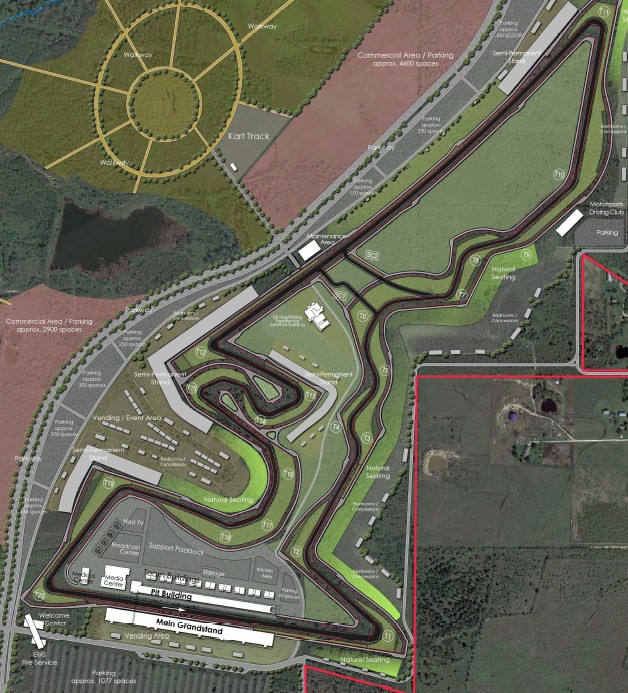Study: Roadwork can’t be finished before F1 race
 |
| Latest Master Plan drawing of the Austin F1 facility |
Clearing fans from a planned Formula One racetrack southeast of Austin within three hours would take as much as $15 million in major road improvements which even in the best case could not be completed by the projected 2012 opening date, according to an analysis of the site performed by Travis County planners.
Consequently, for the first Grand Prix races, "we're looking at minor improvements to the existing system" and "intensive traffic management," said Joe Gieselman, manager of Travis County's Transportation and Natural Resources Department.
The county's presentation Tuesday coincided with local promoters' second visit to the Travis County Commissioners Court seeking permits to site and build the estimated $200 million facility east of Austin-Bergstrom International Airport.
During his initial presentation two weeks ago, Full Throttle Productions attorney Richard Suttle fielded sharp questions from commissioners about the F1 organizers' lack of traffic studies and other basic information that county officials said they needed to make even preliminary decisions about the project.
On Tuesday afternoon, Suttle apologized for the slow start and promised to work closer with Travis County to get the plans approved.
"We heard (you) loud and clear," he said. "The information flow is going to open up."
As part of that promise, Full Throttle filed documents and maps Tuesday that displayed a fuller picture of the proposed 900-acre complex, including building locations, curving walkways and parking lots. The site plan also depicts a kart track and a "luxury" membership-only motor sports driving club.
Previously, organizers had submitted only grading plans. County planners had complained that they could not begin to evaluate the proposal's impact on traffic and safety without other crucial information, such as knowing where buildings and the track's entrances and exits would be.
Suttle also said organizers recently had initiated an environmental study and hired two traffic engineering firms — one of which worked on the Grand Prix site in Silverstone, England — to conduct studies of the Austin site.
"Everybody has an interest in being successful from a traffic standpoint," he said.
It is still unclear who would pay for the improvements. Developers typically pay for most upgrades considered necessary to allow the site to function smoothly.
With an estimated 120,000 fans descending on the track on the race weekend's busiest day, county officials said they anticipate 35,000 vehicles and an additional 15,000 people arriving by bus. To clear the facility after the race in three hours — the average time it takes race fans to get out of Texas Motor Speedway in Fort Worth — Gieselman said several lanes would have to be added to FM 812 and Elroy Road.
Taking into account the time needed to purchase rights of way, move utilities and lay pavement, "two years is not enough time to put in the infrastructure needed to get down to three hours," he said. "I would not look for the major improvements to be done by the first race." The Statesman
